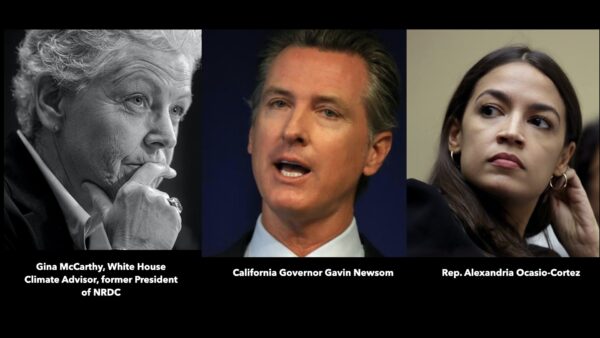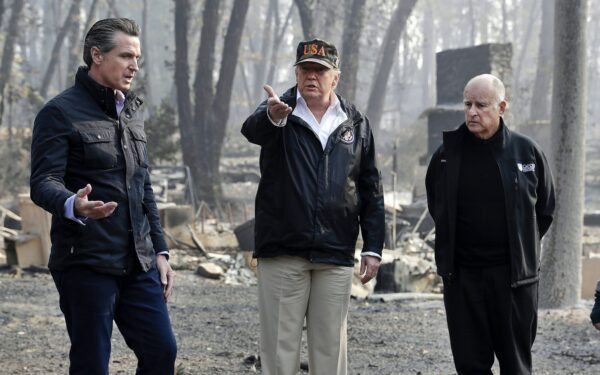Hot Harley Nights 25th Anniversary raises funds for charity
By Wayfarer |
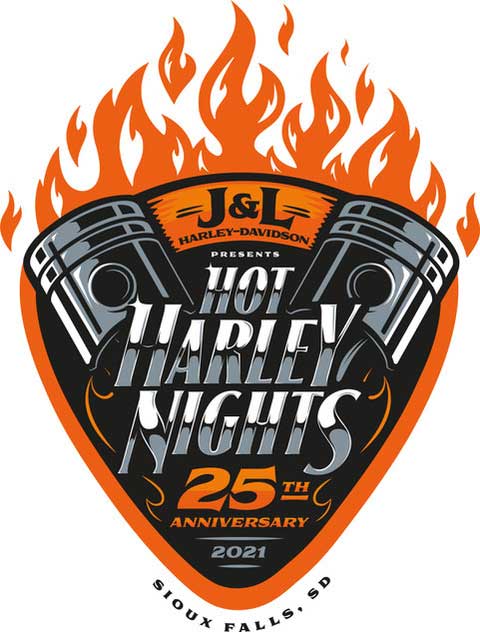 Hot Harley Nights Motorcycle Rally Resumes its Mission To Raise Funds For Make-A-Wish While Providing Fun-filled Weekend of Motorsports and Entertainment.
Sioux Falls, SD (July 06, 2021) – This year marks the 25th anniversary of Hot Harley Nights , and organizers have lined up a jam-packed slate of top-flight motorsports and entertainment events. Hosted by J&L Harley-Davidson, this year’s rally takes place July 9th – 11th at J&L Harley-Davidson and the W. H. Lyon Fairgrounds in Sioux Falls, SD. While the rally is known for its riding, music, stunt shows, racing and more, the priority has always been to generate funds for Make-A-Wish South Dakota, and Hot Harley Nights has raised over $3.5 million for this worthy cause over the past 24 years.
“Our mission has always been charity-driven,” said Hot Harley Nights organizer and J&L Harley-Davidson Co-Owner Jimmy Entenman. “But we’re looking to have as much fun as we possibly can during the process. We’ve got a lot going on during the weekend, but I think I’m most excited about country superstar Rodney Atkins, our music headliner for Saturday night—I am keyed up and ready to go!”
Festivities kick off at J&L Harley-Davidson on Friday, July 9, at 9 a.m. Patrons can avail themselves of excellent food and drink, National HOG Pin Stop, Silent Auction, and free Harley-Davidson demo rides. The Hot Harley Nights Rider Justice Poker Run Scramble starts at 10 a.m.—participants can turn in completed cards later that day or stretch things out and return them Saturday or Sunday.
Other riding opportunities on opening day include the J&L Harley-Davidson Owners Ride, Glacial Lakes Harley-Davidson Run to Hot Harley Nights, Hooligan Flat Track Clinic and the Regions LARGEST Ride-in Bike Show.
Bookending Day 1 of Hot Harley Nights will be the thrilling stunt riding of Rhett Rotten in his authentic 1930s wood-constructed bowl known as the Wall of Death, starting with the first of four daily shows at 9 a.m., and the musical stylings of premier 80s rock tribute band Arch Allies, who close out the night with the music of Journey, Styx, Bon Jovi, Def Lepperd, REO Speedwagon, Boston, and many more.
Day 2 begins bright and early on Saturday, July 10, at 9 a.m. Rally goers can look forward to more Rhett Rotten Wall of Death stunt shows throughout the day, as well as more free H-D demo rides, Guided Rides hosted by Sioux Falls Harley Owners Group, Speed-Kings Custom Harley Show, Shinko Tire and HardDrive Burn Out Contest and the Hot Harley Nights Motorcycle Parade. Then things shift to the W. H. Lyon Fairgrounds for J&P Cycles Dirt Dash Hooligan Racing, the Rhett Rotten Roller Show and music from Rick Monroe and the Hitmen and Rodney Atkins.
And as if that wasn’t enough, the Hot Harley Nights 25th Anniversary Rally finishes up on Sunday with more demo rides, more Rhett Rotten, the J&P Cycles Hooligan Dirt Dash, the J&L Harley Ride to Wagon Wheel and a musical performance by former rocker-turned-country-phenom Darius Rucker.
Sponsors for this year’s Hot Harley Nights include Sanford Health, J&L Harley-Davidson, Harley-Davidson of Fargo, Big Sioux PowerSports, Budweiser, Chesterman Co, First PREMIER Bank, Glacial Lakes Harley-Davidson, Great Western Bank, Howe Plumbing & Heating, Interstate PowerSystems, Jans Corporation, J&P Cycles, Make-A-Wish, McKinney Olson Insurance, Rider Justice, South Dakota Pork Producers Council, Soukup Construction, Speedkings, Those Guys ABATE, Tony’s Catering, and Woods Fuller Schultz & Smith.
J&L Harley-Davidson’s Hot Harley Nights 25th Anniversary runs Friday, July 9, through Sunday, July 11. New and returning riders can find out anything they ever wanted to know about Hot Harley Nights Motorcycle Rally by visiting www.hotharleynights.
Hot Harley Nights Motorcycle Rally Resumes its Mission To Raise Funds For Make-A-Wish While Providing Fun-filled Weekend of Motorsports and Entertainment.
Sioux Falls, SD (July 06, 2021) – This year marks the 25th anniversary of Hot Harley Nights , and organizers have lined up a jam-packed slate of top-flight motorsports and entertainment events. Hosted by J&L Harley-Davidson, this year’s rally takes place July 9th – 11th at J&L Harley-Davidson and the W. H. Lyon Fairgrounds in Sioux Falls, SD. While the rally is known for its riding, music, stunt shows, racing and more, the priority has always been to generate funds for Make-A-Wish South Dakota, and Hot Harley Nights has raised over $3.5 million for this worthy cause over the past 24 years.
“Our mission has always been charity-driven,” said Hot Harley Nights organizer and J&L Harley-Davidson Co-Owner Jimmy Entenman. “But we’re looking to have as much fun as we possibly can during the process. We’ve got a lot going on during the weekend, but I think I’m most excited about country superstar Rodney Atkins, our music headliner for Saturday night—I am keyed up and ready to go!”
Festivities kick off at J&L Harley-Davidson on Friday, July 9, at 9 a.m. Patrons can avail themselves of excellent food and drink, National HOG Pin Stop, Silent Auction, and free Harley-Davidson demo rides. The Hot Harley Nights Rider Justice Poker Run Scramble starts at 10 a.m.—participants can turn in completed cards later that day or stretch things out and return them Saturday or Sunday.
Other riding opportunities on opening day include the J&L Harley-Davidson Owners Ride, Glacial Lakes Harley-Davidson Run to Hot Harley Nights, Hooligan Flat Track Clinic and the Regions LARGEST Ride-in Bike Show.
Bookending Day 1 of Hot Harley Nights will be the thrilling stunt riding of Rhett Rotten in his authentic 1930s wood-constructed bowl known as the Wall of Death, starting with the first of four daily shows at 9 a.m., and the musical stylings of premier 80s rock tribute band Arch Allies, who close out the night with the music of Journey, Styx, Bon Jovi, Def Lepperd, REO Speedwagon, Boston, and many more.
Day 2 begins bright and early on Saturday, July 10, at 9 a.m. Rally goers can look forward to more Rhett Rotten Wall of Death stunt shows throughout the day, as well as more free H-D demo rides, Guided Rides hosted by Sioux Falls Harley Owners Group, Speed-Kings Custom Harley Show, Shinko Tire and HardDrive Burn Out Contest and the Hot Harley Nights Motorcycle Parade. Then things shift to the W. H. Lyon Fairgrounds for J&P Cycles Dirt Dash Hooligan Racing, the Rhett Rotten Roller Show and music from Rick Monroe and the Hitmen and Rodney Atkins.
And as if that wasn’t enough, the Hot Harley Nights 25th Anniversary Rally finishes up on Sunday with more demo rides, more Rhett Rotten, the J&P Cycles Hooligan Dirt Dash, the J&L Harley Ride to Wagon Wheel and a musical performance by former rocker-turned-country-phenom Darius Rucker.
Sponsors for this year’s Hot Harley Nights include Sanford Health, J&L Harley-Davidson, Harley-Davidson of Fargo, Big Sioux PowerSports, Budweiser, Chesterman Co, First PREMIER Bank, Glacial Lakes Harley-Davidson, Great Western Bank, Howe Plumbing & Heating, Interstate PowerSystems, Jans Corporation, J&P Cycles, Make-A-Wish, McKinney Olson Insurance, Rider Justice, South Dakota Pork Producers Council, Soukup Construction, Speedkings, Those Guys ABATE, Tony’s Catering, and Woods Fuller Schultz & Smith.
J&L Harley-Davidson’s Hot Harley Nights 25th Anniversary runs Friday, July 9, through Sunday, July 11. New and returning riders can find out anything they ever wanted to know about Hot Harley Nights Motorcycle Rally by visiting www.hotharleynights.ART INSPIRED RUMBLE SIDECAR PROJECT
By Bandit |

Decades ago (mid ‘90s) Paisano Publications came out with an upscale magazine called VQ. I’m sure a take-off on GQ. People scoffed because the RUB thing was in full swing. I didn’t care because it was another great publication from bikers for bikers. It was tailored for the upscale market complete with ads for cologne, soap and other things you’d never find in Easyriders. The best part was a feature on artists concepts.

Honestly, I think Joe Teresi was way ahead of his time with this one. Starting in the ‘00s this would have fit right in. VQ’s editor, Keith (Bandit) Ball was running it while juggling the editorship of Easyriders and countless other publications.

In 1997 the issue of VQ featured illustrations from a concept artist Tim Conder. The concept was a left-hand sidecar. The shapely notion struck me to the core. I’ve seen state-of-the-art custom bikes from all over the world, from incredible builders, but never saw a concept that I wanted to copy or duplicate in anyway. I’ve been building bikes well over 40 years.

Around the same time, during Daytona Bike Week, Joe Teresi gave me a sharp VQ money clip. I have used it for over 20 years. You’ll note the money clip logo now resides in the steering damper knob. A nod to Joe and Keith (some call him Bandit).

Conder’s conceptual illustration really hit me. I called Keith and inquired, who the hell is Tim Conder? The reply was that he was in Sonoma, 90 miles away. I called Conder and asked if anyone has ever built this sidecar? His reply was no, and he would really like to see it done.


My life was crazy busy being the guy behind the scenes at Custom Chrome bringing it to crazy growth heights. I was involved in every aspect of that company from product development to marketing, sales and much more. I was lucky to build a bike every two years. So, I tore out the VQ illustrations and filed them with my future projects.

The year 2004 brought a couple of big changes for me. I left Custom Chrome, started Hollister H-D and relocated it to Morgan Hill, where I renamed it House of Thunder H-D. During the move, my file cabinet popped open, dropped my build files and low and behold, out came Tim’s sidecar conceptual illustrations.

I worked building a dealership for several years, never being able to really dedicate the time.

I sold House of Thunder H-D in 2015. In 2019 I dedicated 20 hours a week, threw away over a years’ worth of work, because I wasn’t happy with it. Finally, in 2020 I decided I would dedicate 40-50 hours a week and build the best bike/sidecar that I could, no matter how long it took.


The bike is based on a ’04 Softail with mild engine and gearing mods, including double-bronze powder-coated. Wheels, which are real Halibrand knockoffs running 17-inch radial tires all around, 180 in the front, 200 series in the rear.


Proportioning valve is used to balance the rear brakes on the sidecar and bike. GMA brake pulley kit for the rear of the bike and a Brembo in front. Made the handlebars and used Custom Cycle Engineering Controls.

Fit and finish is my expertise, so when you look at the handlebar cover, you’ll see how tight it fits. It looks stock but it’s not. The steering damper poking through is where I machined a spot for the VQ money clip.

Things like the gap at the bottom of the headlight ring really bug me, so I blended in a filler piece. Nacelle headlight strip needed to be extended with a small double step next to the handlebar cover. That double step is mimicked at the bottom of the grill in front of the engine and the inside center of the windshield.


I did a lot of the body work with trim pieces in place, so I would get the fit as tight as possible before sending things off for chrome. And yes, I even made my own key out of an antique gas valve handle.


I built fully polished, louvered-aluminum belly pans on the sidecar and the bike. Not to mention polished aluminum inner fender wells, my own taillight housings and lens. I know, I’m sick.


I hand bent the sidecar interior trim and hid all the hardware. The Jarrah exotic wood floor was sourced from western Australia, sanded and eight coats of clear added to reach the finish I wanted.



Of course, no project of this size can be done all by yourself. Bob Munroe (Grand National Hall of Fame) took my wooden windshield frame and turned it into steel along with the fender trim and extended fuel tank.


The one-off paint was done by the great hall of famer Art Himsl, who has painted several bikes for me in the past and is just a pleasure to work with. Dennis’ Body shop did the final body work to get everything straight.
 mold on top.jpg)
Guy Ruchonnet was invaluable helping with the frame, fender braces, bucks and molds. Nothing is more rewarding than to work with pure craftsmen and watching them take my work and refining it.


Some of the people who helped and inspired me are no longer with us like Darrell Hayes and Don Ivie, whom I miss every day, and both could always get me out of a tight corner.
.jpg)







Okay, so it took me over 20 years to complete this project, so what! It’s finished. It’s the best bike I’ve ever built. It’s beautiful on top as well as underneath and I hope to show it to you in a regional show soon!

Rumble Sidecar Specifications
Owner: Dan Stern
Bike: 2004 Harley-Davidson Softail w/left-hand sidecar
Engine: 88-inch Twin Cam powder coated double bronze

Wheels: Halibrand knockoffs
Brakes: Brembo front, GMA rear
Handlebar: Custom by Stern
Hand Controls: Cycle Controls
Front Suspension: Shovel adjustable tree, extended tubes

Rear Suspension: Works Shock
Fuel Tank: Extended by Bob Munroe

Fenders & Body Panels: Handmade by Guy Ruchonnet & Stern



Paint: Art Himsl custom blend

Seat: Corbin

Special Features: Fender Trim, handmade taillight housing & lenses, louvered belly pan


Suspension: Auto air shocks



Features: Custom matching luggage behind seat, machined footrests, custom interior and side trim, rock guard, fender and taillight trim.





Custom Harley-Davidson Dyna from Bad Land garage
By Wayfarer |
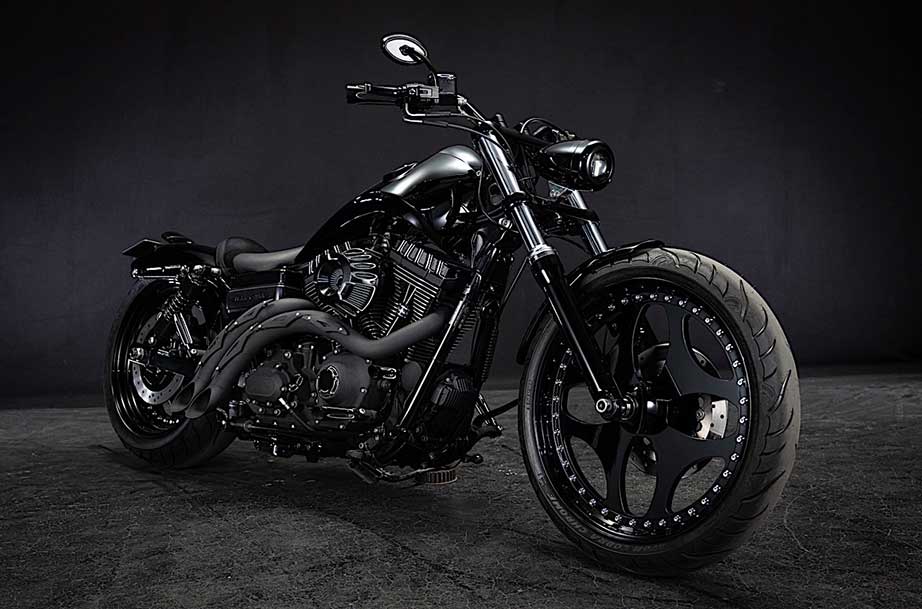
by Daniel Patrascu from https://www.autoevolution.com
The Japanese have a real thing for the lotus flower. In fact, its importance is not limited to Japan alone, but is a pillar of Buddhism, which considers it the purity of the body, speech and mind, born out of Gautama Buddha own steps. It’s not that often though that the lotus is associated with a material object, especially a motorcycle.
A Japanese custom shop that goes by the name Bad Land sees however no issue with associating purity with a two-wheeler, and a menacing-looking one at that.
Holly Lotus is how one of the shop’s builds is called, originally a 2010 Harley-Davidson Dyna that received a host of custom upgrades, black paint and body tattoos that make it look anything but pure.
Just like in the case of the Zoso Blood No. 2, the Holly Lotus goes for a darkened look in the purest Japanese style, with the entire build wrapped in black.
There are a lot of custom parts featured on the build, many of them made by Bad Land itself. The list includes the front and rear wheels, sized 21- and 18-inch, respectively, a unique, pointy headlight that really stands out in the crowd, and a custom handlebar.
The shop is also responsible for the one-off fuel tank, front fender, and exhaust system. All these are paired with a motogadget speedometer, a single Arlen Ness mirror, Arlen Ness grips and covers for the air cleaner and rocker, and a Progressive shock.
The motorcycle was first shown back in May this year, but the Japanese garage did not specify how much the bike cost to put together. We also don’t know what happened to it after completion, but we’ll keep our eyes open in the hopes of catching this Holly Lotus out in the open, in a more natural environment than the studio it was pictured in when revealed.
Check out https://www.badland.net/hd-custom/2010tc-dyna-holly-lotus/
Review of Triumph Thruxton RS 2021: a factory cafe racer
By Wayfarer |
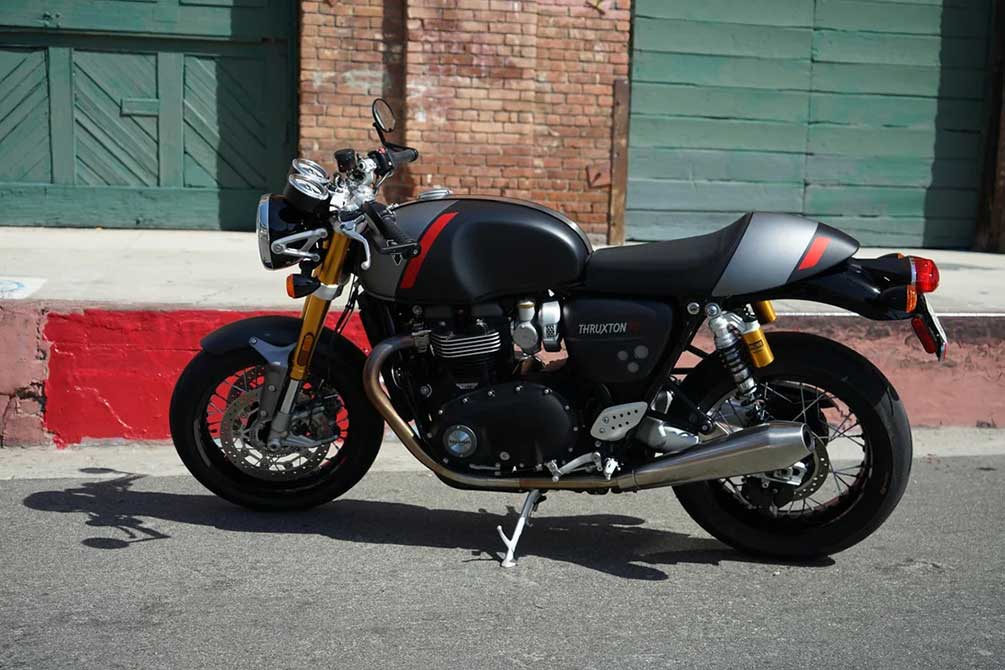
by Kyle Hyatt from https://www.cnet.com
Everyday café: Triumph’s factory cafe racer offers an engaging ride and killer looks, but is it worth the sky-high asking price?
The Thruxton RS is arguably the crown jewel of Triumph’s Modern Classic lineup of motorcycles. It’s an interesting mashup of modern, high-end components and technology, with a decidedly old-school powertrain. It’s a bike that shouldn’t make sense, but after spending time with it, it’s a bike I can’t get out of my head.
The 2021 Triumph Thruxton RS is powered by a 1,200-cc liquid-cooled 270-degree parallel-twin engine, which produces 103 horsepower at 7,500 rpm and 83 pound-feet of torque at just 4,250 rpm. It’s an engine that, thanks to its large displacement and firing order, makes a noise that will get your heart pumping, even if its performance pales in comparison to more conventional naked and sport bikes.
The engine delivers its power smoothly, thanks to Triumph’s excellent fueling. The bike routes its power through a smooth six-speed sequential transmission and out a chain final drive. The gearbox offers light, crisp shifts and an easy-to-find neutral. The age of the engine’s design shows, but that’s a good thing, given Triumph’s continued development.
The formerly-range-topping RS is now the only Thruxton model you can get, and so Triumph seems to have spared no expense in kitting it out with the best-possible chassis components. While the Thruxton’s frame is a conventional and old-timey tubular steel affair, the suspension is modern and well considered. The front fork comes from Showa and uses that company’s “Big Piston” design as found on high-end sport bikes. It’s fully adjustable and makes for a controlled and plush ride, even over bumpy pavement.
The rear shocks (that’s right, two — this is a heritage bike, after all) come from Ohlins and are also fully adjustable. Typically, in my experience, twin-shock bikes don’t necessarily offer the best control over broken pavement or on fast roads, but these Ohlins units toss all that out the window. The back end of the Thruxton feels as comfortable and confident as I could hope for. It uses some fairly trick wheels to help with its handling, too. It has 17-inch, 32-spoke wire wheels, but unlike most wire wheels with steel spokes, the Thruxton uses weight-saving aluminum spokes. The wheels are wrapped in sticky Metzeler Racetec tires.
The brakes come from Brembo, and as such, they’re excellent. Having big Brembo brakes on a motorcycle isn’t unlike stopping at a Starbucks on a long road trip. Sure, there are other options, but this way you know exactly what you’re in for. In the case of the Brembos, what you’re in for is an excellent feel from the lever, huge stopping power and almost jewel-like build quality. The twin front rotors on the RS are sized at 310 millimeters and gripped by Brembo M50 four-piston radial-mount calipers. The single rear rotor comes in at 220 millimeters and is clamped by a single, twin-piston Nissin caliper.
The Thruxton has anti-lock brakes, but they’re not lean-sensitive since the bike lacks an inertial measurement unit. On a bike like the Thruxton — one that’s more about looking good and having fun than outright speed — this is totally acceptable. The Thruxton also packs user-selectable ride modes, which include Road, Rain and Sport. I generally find myself leaving the bike in Sport mode all the time because I like the extra responsive throttle. The Thruxton RS features a very handsome analog speedometer and tachometer. Each also packs an LCD display that provides all the pertinent rider information that I want to see — fuel level, gear indicator, trip odometer, etc. It’s a bit old school, but so is the bike.
When it comes to ergonomics, cafe racers aren’t generally what I’d call comfortable for longer rides. They feature a more leaned-forward, sport bike-like stance, which looks great and makes for agile handling, but can be hard on your wrists. The Thruxton somehow manages to pull off the cafe racer look while remaining relatively comfortable. The bike is slightly more upright than it might seem at first glance and a generous rider triangle means that even someone like me at 6 feet, 4 inches doesn’t feel incredibly cramped. Footpeg clearance is good, too, so leaning the bike way over isn’t an issue.
With a seat height of nearly 32 inches, the Thruxton may be a bit of a struggle for some smaller riders when it comes time to get both feet on the ground at a stop. It’s also not especially light, at 434 pounds dry, so that might also be something for smaller riders to consider. The Triumph Speed Twin might be better, in that case.
The Thruxton is a bike that somehow manages to ride as good as it looks, which is saying something. It’s easy to putter around town on, thanks to its compliant ride and torquey, under-stressed engine. It’s also a riot on a curvy road, thanks to its sticky tires and aggressive-ish riding position, and there are few pleasures greater than hearing the Thruxton’s big twin-cylinder engine echo off of canyon walls at 7,500 rpm.
The Thruxton RS is a fantastic machine, but of course, it should be, given its price tag. All of the motorcycle jewelry that Triumph bestows on the RS means that it’s packing a hefty asking price of $16,200. There is an almost limitless number of other motorcycles that can offer more performance or utility than the Thruxton for that money (or less). Still, I struggle to think of one that can offer performance with as much style.
Custom Harley-Davidson Is All About America, Built Elsewhere
By Wayfarer |
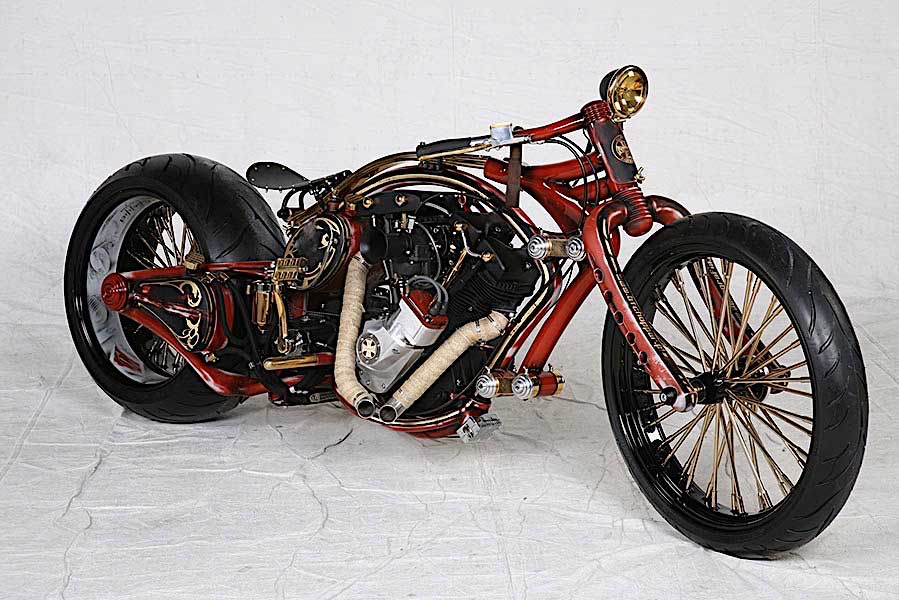
by Daniel Patrascu from https://www.autoevolution.com
Motorcycles and freedom are two notions that are most often associated with the American way of life. Responsible for the former are the local bike makers, of course, with Harley-Davidson playing a big part. As for the latter, well, it’s the way Americans chose to build and run their society.
These two notions have spread fast around the world, and you don’t need us to tell you that, at least as far as freedom goes. But you might need us to find out about the countless motorcycle builders out there that take a lot of inspiration from American motorcycles when doing their own projects.
For more than a year now, we’ve traveled virtually around Europe to uncover custom motorcycle projects based on Harley-Davidson bikes. We found most of them in Germany, where many custom shops exist, but there are incredible ideas coming from elsewhere as well.
Like, say Poland, where a shop by the name BTChoppers resides. Like a lot of other European businesses of its kind, it too got recognition from the land of Harley-Davidson, and the bike maker itself.
Back in 2011, for instance, during the AMD World Championships in Sturgis, South Dakota, Harley awarded the Pick of Excellence title to a BTChoppers build. That would be the one we have here, aptly titled Bit of Freedom.
The bike is a custom build from the ground up, meaning it uses a fully custom frame inside, in which a Harley-Davidson shovelhead engine sits cradled.
It was the minimalist style of this bike and the perfectly matching, retro-styled paint job in Red Dark Crimson and gold that caught our eye and made us bring it back into the spotlight as the perfect opener of the broader coverage of the BTChoppers bikes coming our way over the next few months.
So, if you fancy Polish-made bikes with a twist of America, stay close.
BMW Motorrad to reveal a New “Pioneering Electric Vehicle” Next Week
By Wayfarer |
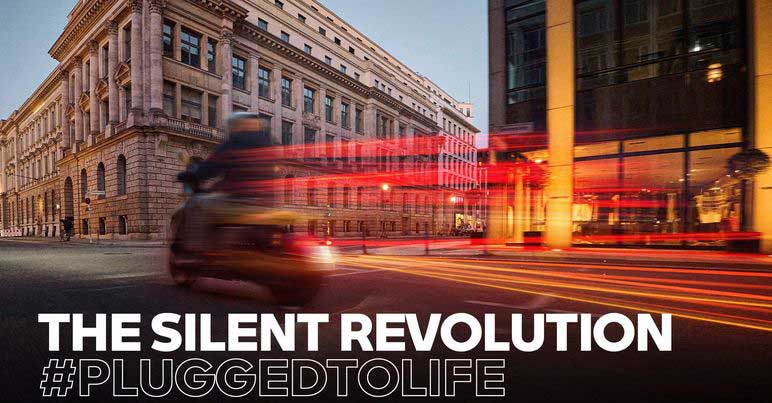
by Daniel Patrascu from https://www.autoevolution.com
For the better part of the last ten years, electricity seemed like the way forward for four-wheeled vehicles alone. Sure, countless motorcycle startups popped up over the years, each trying to break the mold, but each has so far failed.
The first in the large group of established bike makers to go down the electrification path is Harley-Davidson. The Americans have the LiveWire on sale for some time now, but they also seem to struggle to make it stick.
But maybe over in Europe, things will be a bit different. There, BMW’s Motorrad has been more or less secretly working for some time on an electric motorcycle that, at least on paper, should forever change the segment.
Back in 2019, an amazing contraption called Vision DC Roadster was shown. In the place one would usually find a boxer engine, that thing packed a vertically mounted battery, complete with cooling ribs and integrated ventilators. Under the battery, shaped like a cylinder, resided the motor meant to spin the wheels.
Now, the Vision DC was just a concept, but a bit later that same year, something else came into the spotlight. It was called E-Power Roadster, a Frankenstein machine that took the front end of an S1000R and tied it to the rear of an R1200RS.
A lot of time has passed since, and it seems there is still no reveal in sight for electric motorcycles branded by BMW. But there are other things, possibly even as exciting, coming our way from Munich in lesser segments, namely the “urban single-track mobility“ one.
That’s where the Germans say their unveiling from next week will be playing, a pioneering electric vehicle whose teaser image you can see as the main photo of this piece.
No additional info was provided, apart from the fact the vehicle will premiere on July 7.
PRESS RELEASE:
Next Wednesday, BMW Motorrad will celebrate the world premiere of a pioneering, electric vehicle. The presentation will be streamed online.
Wednesday, 7 July 2021 – 10:00 am (CEST)
The online presentation will be broadcast on various channels of BMW Motorrad and the BMW Group. The live stream will be on the official Facebook page of BMW Motorrad, the YouTube channels of BMW Motorrad as well as the BMW Group and the BMW Group LinkedIn page.
https://www.facebook.com/BMWMotorrad
https://www.youtube.com/BMWMotorrad
Following this online presentation, further information on the topics of product and design will be answered by experts in a live chat on the BMW Motorrad channels.
Both events will be held exclusively in English to provide access for a broad, interested audience.
The 8 Motorcycles Reproduced with Insane Realism in RiMS Racing
By Wayfarer |
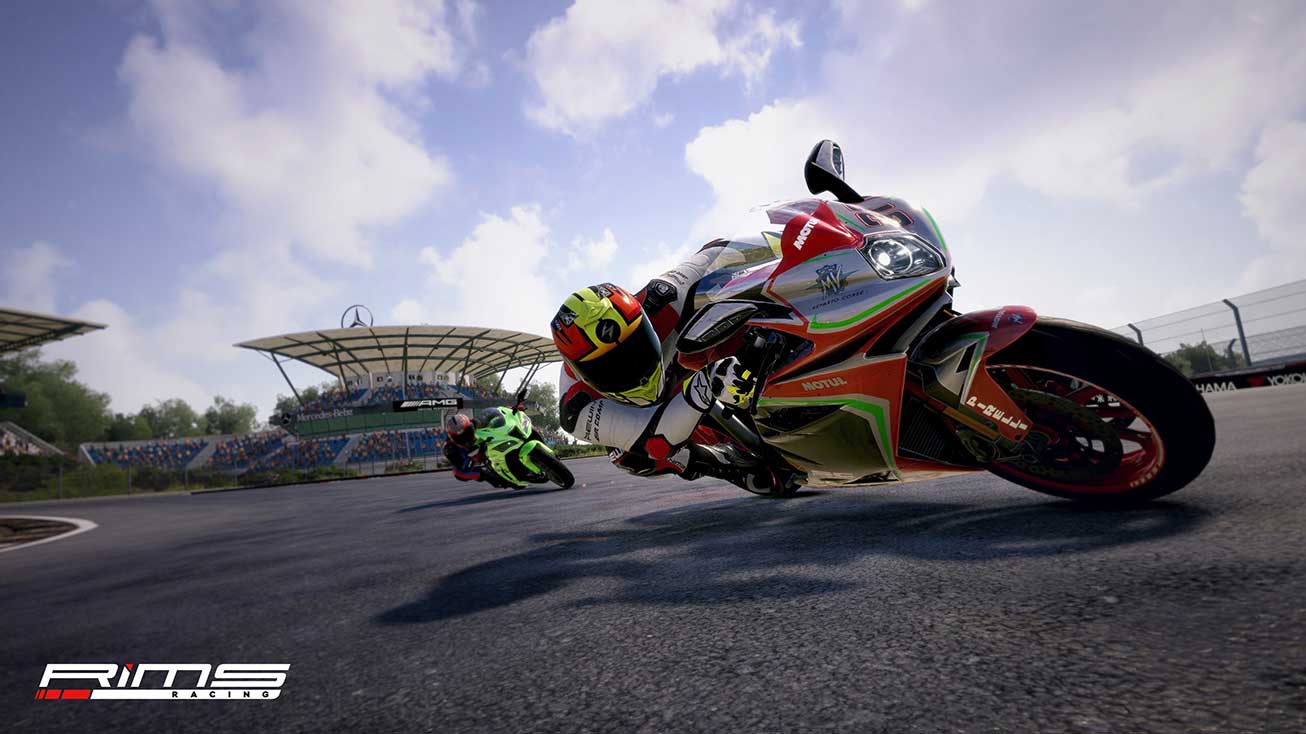
by Bogdan Popa from https://www.autoevolution.com
RiMS Racing is one of the most anticipated game releases of the year for moto racing fans, especially as Nacon and RaceWard Studio have promised to accurately reproduce the fastest bikes out there in this new title.
So in theory, RiMS Racing is supposed to feel stunningly real from one end to another, and based on a new video published by the two companies, it looks like this is very likely to happen.
Nacon has published gaming footage recorded on the Suzuka circuit in Japan, allowing us to see how the 2019 Kawasaki Ninja ZX-10RR behaves on the track. And at the same time, the video also reveals other tidbits about the game, including the customization screen where you can change nearly every little detail about the motorcycle you’re about to hop on for the next race.
And last but not least, Nacon has also shared the list of eight motorcycles that will be available in the game: the Kawasaki Ninja ZX-10 RR, Aprilia RSV4 1100 Factory, BMW M 1000 RR, Ducati Panigale V4 R, Honda CBR1000RR ABS, MV Agusta F4 RC, Suzuki GSX-R1000R and the Yamaha YZF-R1.
As we said earlier, every single model comes with insane realism, and you can figure this out by simply checking out the video we embedded below. It’s pretty clear Nacon and RaceWard struggled to make the whole experience feel as real as possible, and you can almost feel the feedback the Kawasaki gives by simply looking at the video.
RiMS Racing will include over 70 events, and Nacon says it’ll roll out lots of multiplayer challenges after the game finally becomes available this summer.
And speaking of launch date, RiMS Racing is projected to see the daylight on August 19 on pretty much every gaming platform out there, including not only PC, but also consoles. The game will be available on both current and next-gen consoles, as well as on the Nintendo Switch.
House Passes Highway Bill – Biker Priorities Included
By Wayfarer |
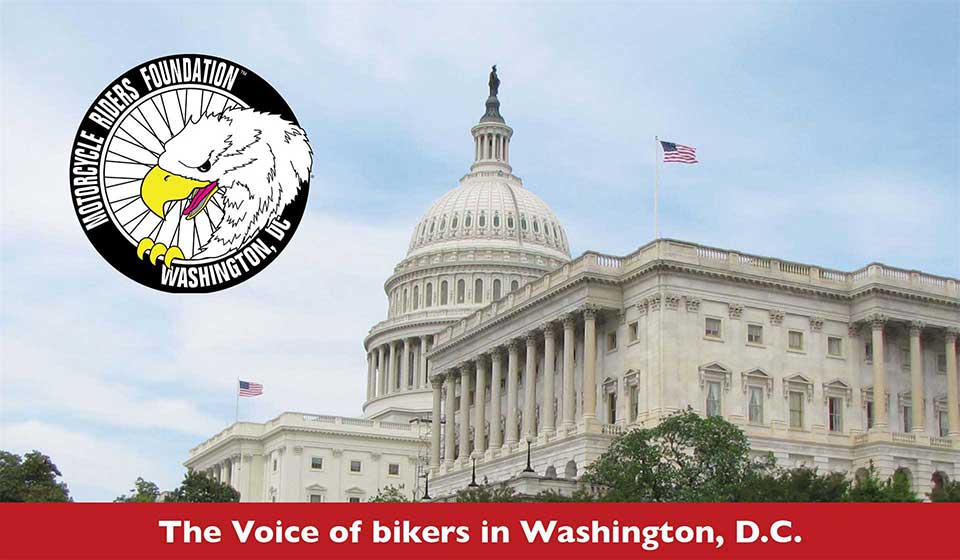
Thursday morning the full House of Representatives passed H.R. 3684 the Investing in a New Vision for the Environment and Surface Transportation in America Act or the INVEST in America Act. This bill is more commonly referred to as the highway bill. The bill is over 1,500 pages, spends $715 billion and includes five beneficial provisions for motorcyclists. The final vote on passage was 221 for and 201 against. Two Republicans voted in favor and no Democrats opposed.
The Senate has begun work on their version of the highway bill and the two chambers will eventually need to work out the differences before an agreed upon bill is sent to the President for his signature. Traditionally, a highway bill has a five-year lifespan before Congress must fund and reauthorize programs again. Typically, highway bills occur in years ending in 0’s and 5’s. The last highway bill expired in 2020 but was given a one-year extension as Congress was unable to reach a compromise. Congress now faces a September 30th deadline to pass a new highway bill and reauthorize crucial transportation and safety related programs.
Below is a brief recap of the five motorcyclist related items that the House of Representatives approved and included in this major piece of legislation:
Profiling: The bill includes an update to current federal law on the issue of motorcycle only check points. The bill passed today includes language that prohibits state and local governments from using funds from the Department of Transportation to “profile and stop motorcycle operators or motorcycle passengers using as a factor the clothing or mode of transportation of such operators or passengers.”
Traffic Stop Data Collection: An amendment to the bill by Congressman Tim Walberg (MI-R) and Congressman Michael Burgess (TX-R) added the term “mode of transportation” to a newly created grant program for racial and ethnic profiling. The program allows states to use federal money to collect data on traffic stops. Originally the only information that states could use the funds for was to record was the driver’s racial and ethnic makeup. With this added language, states will have access to funds to collect the “mode of transportation” of the person being stopped. If states choose to participate in the program, motorcyclists will have access to data on traffic stops and determine if motorcyclists are stopped disproportionally by law enforcement. This amendment was a joint effort by the Co-Chairmen of the House Motorcycle Caucus and was added just hours before the final bill was passed.
Motorcyclist Advisory Council: H.R. 3684 includes a section that reestablishes the Motorcyclist Advisory Council (MAC) and makes needed changes. The MAC has existed for over a decade and allows federal policymakers, state highway officials, and motorcyclists to discuss the unique demands of riding a motorcycle and how roads, bridges, and other infrastructure can be built to better account for motorcyclists’ needs. The bill creates dedicated seats on the council for motorcyclists’ rights groups and manufacturers. It also requires a report every two years be made to the Secretary of Transportation and Congress.
Autonomous Vehicles: The INVEST Act includes specific language requiring that when the Department of Transportation conducts safety studies on autonomous vehicles, motorcycles must be considered as unique roadway users. Additionally, a newly formed working group on autonomous vehicles must include a motorcyclist safety group as part of its membership. As with the MAC, motorcyclists need a seat at the table when our safety and freedoms are being debated.
Motorcyclist Safety Funds: The bill, as passed, would increase the 405 safety funds made available to states for motorcyclist safety by $1,470,000 for the next fiscal year with increases through 2025. This is an increase in the program of roughly 34% over current funding levels. Under this bill, the total amount available to states in the next fiscal year would be $5,760,000.
Visit and join Motorcycle Riders Foundation at https://mrf.org/
The Independence Day Coming Bikernet Weekly News for July 1, 2021
By Wayfarer |
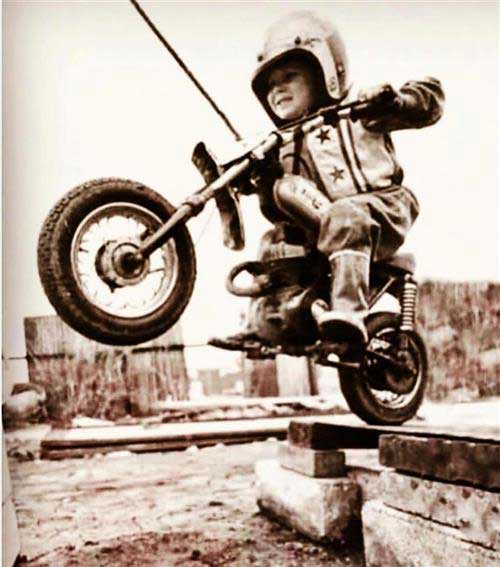
I go from dawn to dusk trying to stay prepared and be pro-active. Then as it reaches about 7:00 I grab a beer and head to a chair under a blooming maple tree to relax with a pile of the Redhead’s most magnificent bowl of guacamole.
We sit and ponder the goals for the next day. Micah is working on our plans for Bonneville. Tonight, after the news I get to have a Jack on the Rocks under the maple tree. And this weekend I want to take the ’69 Panhead out for a test ride.
Let’s hit the news.
Have a terrific holiday and ride free forever!
–Bandit
Click Here to read the Weekly News only on Bikernet.
Join the Cantina for more – Subscribe Today.
https://www.bikernet.com/pages/custom/subscription.aspx
The Real Reason They Blame Heat Deaths, Blackouts, and Forest Fires on Climate Change Is Because They’re Causing Them
By Bandit |
Is it a coincidence that those who say civilization is unsustainable are making it so?
By Michael Shellenberger, Environmental Progress
Journalists, experts, and elected officials are today blaming heat wave deaths, forest fires, and electricity shortages in New York, California, and Texas on climate change, but the underlying cause of those events is lack of air conditioning, lack of electricity, and the failure to properly manage forests, not marginal changes to temperatures.
It’s true that there have been more heat waves in the United States since 1960, and that higher temperatures dry out the dead wood in forests, contributing to a greater area burned by forest fires. “Climate dries the [wood] fuels out and extends the fire season from 4-6 months to nearly year-round,” US Forest Service scientist Malcolm North explained to me last summer.
But what determines whether people die in heat waves is whether or not they have air conditioning, not whether temperatures rose to 111° instead of 109°. Proof of that comes from the fact that heat-related deaths declined in the US by 50% to 75% since 1960 thanks entirely to air conditioning, even as heat waves grew in frequency and length.
What determines whether a fire in a forest is high-intensity or low-intensity is the amount of wood fuel. Climate change is “not the cause of the intensity of the [mountain forest] fires,” stressed North. “The cause of that is fire suppression and the existing debt of wood fuel.”
And what determines whether or not there is enough electricity is whether there are sufficient “baseload,” reliable power plants and fuels, not marginally higher use of air conditioners. The people who manage electricity grids knew perfectly well that it could be hot last summer, hot this summer, and that a cold snap like the one that occurred in Texas in February was likely, since worse cold snaps had occurred in the past.
The main reason there aren’t enough reliable power plants is because progressive activists, scientists, and journalists successfully persuaded policymakers to shut them down, not build them, or not operate them.
And the reason California has failed to properly manage its forests is because, for decades, its leaders underinvested in fire prevention, including by diverting money that the state’s electric utilities could and should have spent on clearing the area around electrical lines, to renewables.
The War on Cheap Energy, Air Conditioning, and Forest Management
In the fall of 2019, President Donald Trump was widely ridiculed for claiming that the high-intensity fires that were burning through California’s forests could be prevented by “raking” the forest floor. Many scientists, journalists, and politicians said Trump was engaged in science denial, consistent with his previously stated skepticism of climate change.
But Trump was right that better forest management would have prevented California’s high-intensity fires. Proof came last summer when a high-intensity fire arrived at a well-managed forest. Instead of continuing to burn the tree crowns, the fire dropped to the forest floor. The reason was because woody debris on the forest floor had been mechanically cleared (“raked”) or burned off, and so the fire didn’t burn as hot or high.
In 2019 and 2020, as California Governor Gavin Newsom was attacking Trump and Republicans as climate deniers, he was actually cutting the budget for forest fire prevention, according to an investigation by the Sacramento bureau of National Public Radio (NPR). The result was a halving of the area treated for fire by Cal-Fire.
It’s hard not to conclude that Newsom was stoking partisanship and climate alarmism to distract from his counterproductive actions. After all, it worked. Where journalists at even progressive publications, like Mother Jones, had previously acknowledged that poor forest management was the cause of the high-intensity fires, the news media last summer inaccurately blamed climate change.
A similar dynamic has been underway on air conditioning. Hundreds of people have died in North America over the last few days from lack of air conditioning. But for years activist analysts, scientists, and journalists have claimed we have too much of it. “The World Wants Air-Conditioning,” warned the New York Times in 2018, “That Could Warm the World.”
Earlier this year, the Natural Resources Defense Council (NRDC) published a report arguing that “skyrocketing cooling demand in India may also worsen the country’s health risks from dangerous air pollution, extreme heat, and climate change.”
At no point in its report did NRDC mention the inconvenient fact that air conditioning had slashed heat-related deaths in the US and other nations, and that it would also do so in India.
The main way NRDC and other environmental groups seek to slow the spread and use of air conditioning is by making electricity more expensive, either directly, through energy taxes or carbon taxes, or indirectly, through regulations or subsidies for the use of renewables.
There is resistance. In 2015, an Indian economist generated headlines after calling for more air conditioning, a view which is considered radical in India, where environmentalists hold great sway. “AC is not a luxury in Kolkata,” said Dr. Joyashree Roy, who was lead author of a 2018 Intergovernmental Panel on Climate Change report. “People suffer from heat stress. The only solution is to air condition
workplaces.”
But environmentalists and journalists pushed back. “Installing air conditioning to combat climate change is bizarre,” said one activist in response to Roy. Others, funded by developed nation donors, insisted that India’s heat deaths meant India should rely more heavily upon weather-dependent renewables.
But New York, California, and Texas stand as warnings. Those states invested hundreds of billions of ratepayer, investor, and taxpayer money into weather dependent renewables, and under-invested, or closed outright, reliable sources of energy, like nuclear and natural gas plants.
The result, from California to Germany to Texas, was significant increases to consumer electricity prices. And higher electricity prices mean, especially in a poor nation like India, less air conditioning.
And weather-dependent energy sources proved uniquely ill-suited to power societies during extreme weather events, as New York City’s current electricity shortage, last summer’s blackouts in California, and this year’s cold snap in Texas, dramatically illustrated.
Last year, California’s renewables could not produce sufficient power during hours of peak demand, 5 p.m. to 10 p.m., because that’s when the sun sets. And the heat wave was in part a result of lack of wind. The California grid operator warned public regulators that solar panels and wind turbines wouldn’t be enough, but they ignored
him, resulting in blackouts.
It was a similar story in Texas in February. Nuclear plants produced 73% while wind turbines produced 2% of their potential output during the worst hour of shortage. Batteries and so-called “peaker plants,” like diesel or gas generators, were not substitutes for large, reliable baseload plants.
Not only are batteries prohibitively expensive, they are only useful if already charged. Over a heat wave or cold snap, they are quickly drained and can’t be recharged if there are energy shortages.
While regulators, moderate Democrats, Republicans, electric utilities, and energy companies in each of those states went along with, and sometimes profited from, moving from reliable to unreliable energy sources, it was progressives who drove the agenda forward.
The result can be seen in New York City. Mayor Bill de Blasio yesterday said people needed to “immediately, immediately reduce the use of electricity in your home.” That’s dangerous because New Yorkers need air conditioning, as the last few days remind us, to survive.
The reason for the electricity shortage in New York wasn’t unanticipated demand but rather the planned shortage of supply. Powerful progressive NGOs like NRDC, along with progressive politicians, including Representative Alexandria Ocasio-Cortez, successfully opposed the construction and operation of new nuclear plants, and demanded the premature closure of an existing one, Indian Point.
Why They Keep Re-Making Apocalypse Now
In September, 2019, climate activist Greta Thunberg condemned “fairy tales of eternal economic growth,” but economic growth is necessary for reliable electricity, air conditioning, and healthy forests.
To a large extent, the apocalyptic claims made about climate change by people in developed nations reflect their ignorance of the infrastructure and practices that protect us, from flood control to baseload power plants to forest management. They take civilization for granted — at least, that is, until it fails, as it is increasingly starting to do.
But it is notable that many of the same journalists, scientists, and activists who blame climate change for natural disasters also oppose the systems, technologies, and practices required to adapt to them. Many even, like Thunberg, oppose economic growth.
Is it a coincidence that the same people who blame heat wave deaths on climate change oppose air conditioning? Is it a coincidence that the same people who blame forest fires on climate change cut the budget for forest management? Is it a coincidence that the people who deny the need for cheap and reliable energy sources, and better forest management, accuse those who disagree of denying climate change?
While we like to imagine that we, and others, are motivated by reason and scientific evidence, decades of psychological experiments show that our reasoning is motivated by preexisting and largely unconscious belief systems.
Today, the dominant belief system of educated elites in developed nations is apocalyptic environmentalism, which holds that modern human civilization is unsustainable and will come to a fiery end unless we harmonize with nature.
Apocalyptic environmentalists may be right that human civilization isn’t unsustainable. But if they are, it won’t be because we can’t generate cheap and reliable electricity, manage our forests, or adapt to climate change. Rather, if human civilization turns out to be unsustainable, it will be because apocalyptic environmentalists didn’t want it to be.


